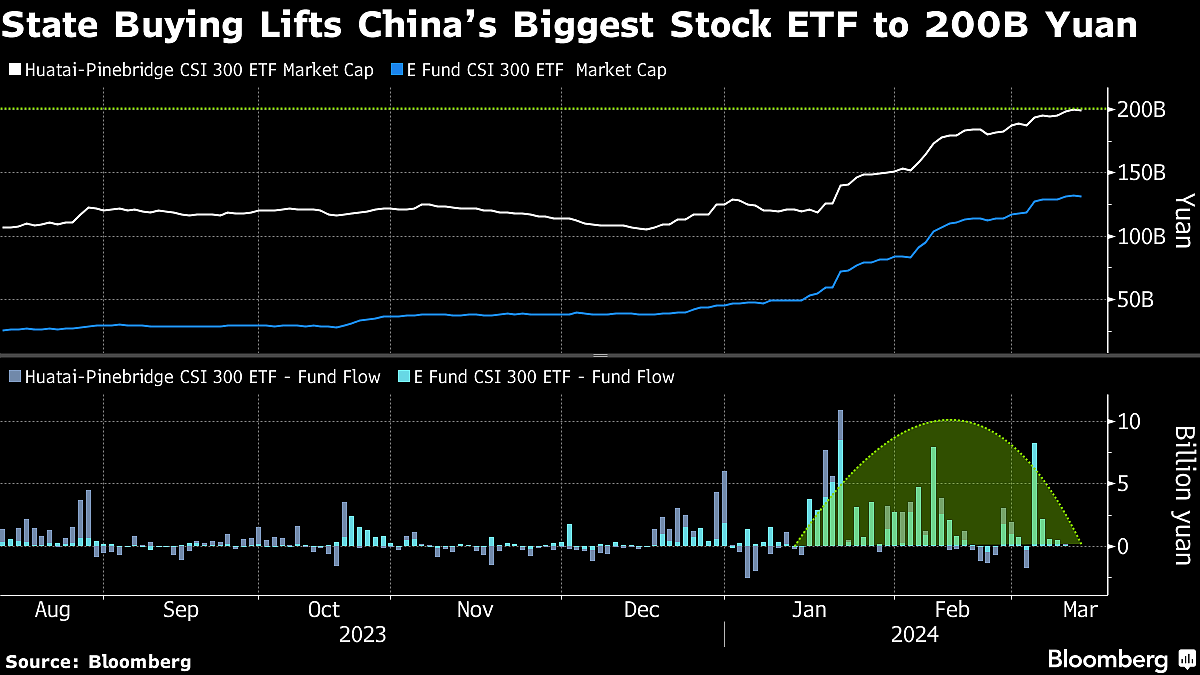Here's How Some China Funds Recovered After The ‘Quant Quake’
Many of China’s beleaguered quant funds are on the mend, and those leading the recovery stuck with the same computer models that helped them withstand years of market turmoil.

(Bloomberg) -- Many of China’s beleaguered quant funds are on the mend, and those leading the recovery stuck with the same computer models that helped them withstand years of market turmoil.
The top 23 quantitative funds tracked by China Merchants Securities Co. beat the benchmark in the week of Feb. 19, some by as much as 12.5 percentage points, after a brutal selloff earlier in the month. While most of them still trail the broader market year to date, firms led by Yanfu Investments LLC and Shanghai Manfeng Asset Management Co., which stuck to their algorithmic guns, outperformed throughout the turmoil, according to data seen by Bloomberg News and interviews with managers.
China’s private quant industry, with 1.6 trillion yuan ($223 billion) of assets under management, is poised for a shakeout amid unprecedented regulatory scrutiny and a quick shift in market trends. The vastly different responses during the crisis showcased managers’ abilities to balance the pursuit of extra returns with risk control, as investors re-evaluate their confidence in algorithm-driven portfolios.
“When a big disaster hits, some species that have adapted well would become extinct, but some others would then thrive,” said Edward Liu, chief investment officer at Manfeng. “Quant investing is the same.”
China’s quant hedge funds suffered a record slump in relative returns last month as the small cap stocks that had helped them beat the market in recent years collapsed. Regulators also cracked down on some quant trading strategies as they sought to end the equity rout. State-backed funds meanwhile focused support on bigger stocks, helping drive a broader rally since Feb. 19.

Many of the quants were caught off guard, and their returns reflect the roller-coaster markets. After a sharp rebound following the Chinese New Year, most of the quants monitored by Merchants Securities trailed the CSI 500 Index in the final week of February, before beating the gauge again last week. Overall, at least nine of the 12 top players the brokerage tracks for enhanced CSI 1000 Index products topped the benchmark in each of the past three weeks.
The turmoil and heightened scrutiny prompted many firms to reassess their strategies. The two previous quant crises in China since 2014 led to upgrades in technology and strategy, followed by an industry reshuffle, according to Manfeng’s Liu.
“This time will be no exception,” he said.
Firms like Manfeng outperformed by sticking to their models, even as many rivals stepped in to tinker, in some cases exacerbating losses. Only eight of the 41 quants tracked by Citic Securities Co. for crisis responses steered clear of human intervention, according to data seen by Bloomberg. Seventeen of them reshuffled portfolios, mostly by dumping small-cap stocks and buying larger ones.
Here’s a summary of how several of the funds dealt with the crisis that some dubbed “the quant quake:”
No Intervention
Manfeng grew cautious from the onset, avoiding stocks with market caps of less than 2.7 billion yuan. It then used deep learning to cull more stocks, a step that led to a tendency for contrarian bets. Its high turnover helped limit unwanted exposure to sectors and larger or smaller stocks, Liu said.
While that strategy would have suffered last year when many quants benefited from a surge in small caps, it helped avert a collapse this year. Manfeng’s CSI 500 enhanced product outpaced the index by 1.2 percentage points this year as of March 8, while the fund tracking the smaller-cap CSI 1000 outperformed by 12 percentage points.
The company “didn’t get to eat the meat, so also didn’t take the beating,” Liu wrote, citing a Chinese proverb.
DMA Products
Tighter risk controls also helped Pinestone Asset Management Co., even for its market neutral product that used so-called Direct Market Access services to add leverage of as much as 300%. Blamed for fueling the meltdown, officials told quants to phase out some DMA products, Bloomberg reported earlier.
Although they didn’t intervene, Pinestone managers noticed that its model automatically reduced leverage on these products to about 100% in late January, according to Chris Huang, director of trading. The deleveraging helped cap the largest drawdown at 9%, allowing them to avoid forced selling.
Yanfu Investments, with more than 50 billion yuan in assets, beat the CSI 300, CSI 500 and CSI 1000 indexes this year by as much as 1.9 percentage points. The main CSI 300 Index is up 4.1% this year through March 13, after three straight years of declines.
Yanfu had “firm confidence in the recovery” once the panic eased, the Shanghai-based firm led by former Two Sigma Investments researcher Gao Kang wrote in a letter to investors. “We knew that it’s the right choice to not manually interfere under such circumstances.”
Shanghai Minghong Investment Management Co., which runs more than 50 billion yuan and didn’t intervene, also beat all three gauges, according to the Merchants Securities data.
Firms Intervening
Reshuffling portfolios triggered regulatory penalties in some cases. Ningbo Lingjun Investment Management Partnership had its accounts frozen for three days after dumping 2.57 billion yuan of shares in one minute. The firm is one of the four largest quants in China, managing more than 10 billion yuan.
Hangzhou-based Longqi Scientific Investment moved to curb risks on Feb. 5, lowering the weightings of sub-strategies that were bottom-fishing for small caps. Its managers stopped short of tightening the scope of stock selection until two days later when they sold small stocks, only to miss a surge in the CSI 2000.
It was an event with “very minimal probability” that happened with an “extremely violent impact,” Longqi said in a reply to Bloomberg News. The company had to either completely depend on the model and take “likely unbearable losses,” or intervene to ensure survival, it said.
More broadly, quants will become more cautious as they seek above-market returns, likely fueling wider use of artificial intelligence, Manfeng’s Liu said. The product structure will also see major changes as positioning of different products becomes clearer, while DMAs fade away.
“The belief in big names has been weakened,” which could result in fewer assets for large funds as investors look for new managers, he said. “It’s like shuffling the cards again.”
More stories like this are available on bloomberg.com
©2024 Bloomberg L.P.